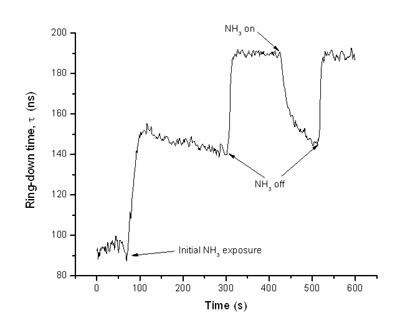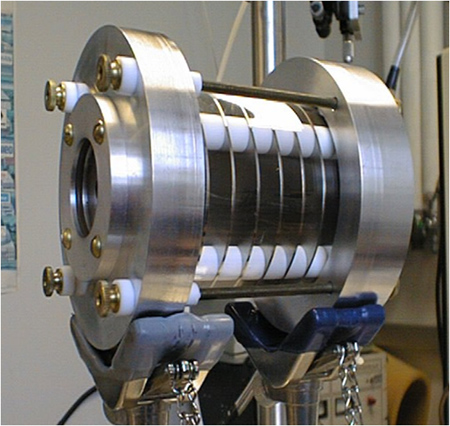|
Research: New Ideas and Instrumentation, Fundamental Plasma Studies, Molecular Analysis and Chemical Sensors, Elemental Mass Spectrometry Molecular Analysis and Chemical Sensors |
|
|
|
|
|
Coupling Laser Ablation with the FAPA Ionization Source to Perform Mass-Spectral Imaging Fiber Optic Chemical Sensing Using Fiber-Loop Ring-Down Spectroscopy Desorption/Ionization Coupled with Ion Mobility Spectrometry |
|
|
|
|
|
|
|
|
|
|
|
|
|
Laser ablation has been coupled with the flowing atmospheric-pressure afterglow (FAPA) ionization source. When 266 nm laser light is focused onto a spot, a small amount of material is ablated. The resulting aerosol is then transferred by a nitrogen stream into the afterglow for desorption/ionization. The ionized sample is then analyzed with a time-of-flight mass spectrometer. A two-dimensional mass-spectral image can then be generated by scanning the laser beam across the surface. With this technique, spatial resolution of ~20 um has been achieved. One advantage of using laser ablation rather than laser desorption is that depth information can also be gained. The resulting combination of laser ablation and our FAPA source has been used to examine several sample surfaces for a wide variety of analytes extremely sensitively. For example, the above Indiana University logo was printed on paper with caffeine-doped ink and subsequently imaged. A limit of detection of 5 fmol for caffeine has been achieved with this technique. The method is now being applied to tissue samples.
|
|
|
|
|
|
Cavity ring-down spectroscopy (CRDS) is widely known as an ultra-sensitive method for trace detection of gases via absorption of laser light. Unfortunately, CRDS ordinarily involves the use of highly reflective mirrors, a laser, and a carefully aligned optical cavity. These requirements have recently been relaxed due to the demonstration of absorption measurements with an optical fiber loop. In our group, this fiber-loop ring-down (FLRD) method has been applied to the field of chemical sensing. The plastic cladding of the optical fiber was doped with phenol red which, in the presence of ammonia, absorbs the evanescent wave caused by a shift in the absorbance maximum of the dye. This shift results in a decrease in ring-down time. The result is a very sensitive and inexpensive sensing/detection system that can be used in a broad range of applications.
|
|
Desorption/Ionization Coupled with Ion Mobilty Spectrometry
|
|
|
|
|
|
Ion mobility spectrometry (IMS) is an effective method for gas-phase separations of charged molecules. Analysis by IMS is a relatively simple process based upon the field-induced migration of a charged molecule through a buffer gas. We have recently coupled IMS and the flowing atmospheric-pressure afterglow (FAPA) ionization source similar to the above diagram. This design allows us to operate at atmospheric pressure throughout the system, so vacuum pumps are not required. This instrument permits rapid analysis of solid surfaces by direct desorption/ionization from a solid sample, eliminating much of the tedious process of sample preparation. The goal of this project is to miniaturize the set-up, yielding a sensitive, field-deployable instrument.
|
|
|
|
|
 |
|
|
In the search for organisms on other planets, an effective method is to look for prominent markers of life as we know it. The energy molecule adenosine-triphosphate (ATP) provides a ubiquitous indicator of cellular life. A sensitive assay exists for ATP that takes advantage of a natural enzyme. Firefly luciferase, when combined with the substrate luciferin and two cofactors, catalyzes a reaction that efficiently releases light (quantum efficiency >90%). The use of this enzyme represents a simple, selective, and sensitive means to determine the presence of ATP and, in turn, living organisms. Overall, the goal is to develop a robust, on-line, flow-injection-based chemiluminescent sensor for this application.
|
|







